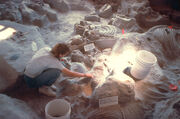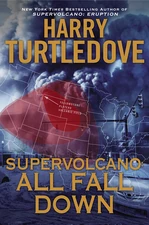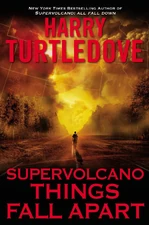
Ashfall Fossil Beds State Historical Park is a branch museum of the University of Nebraska State Museum (UNSM).
The Fossil Beds are among the rare preservation sites called lagerstätten, which preserve ecological "snapshots" from a moment in time, due to extraordinary local conditions that have preserved a range of fossilized organisms undisturbed. The Ashfall deposit preserves the fossilized remains of ancient animals that perished in a dense volcanic ashfall which fell during the late Miocene approximately 12 million years ago; the animals had come to a waterhole seeking relief. The fall of ash drifted downwind from the Bruneau-Jarbidge supervolcano eruption (in present-day Idaho), nearly 1,000 miles (1,600 km) west of the Ashfall site. A large number of very well-preserved fossil rhinos, small three-toed horses, camels, and birds have been excavated. Many animals were preserved with their bones articulated; one rhino still bears her unborn fetus, while others retain the contents of their last meal.
Newly uncovered fossils are being left exactly as they are found: specially constructed walkways afford visitors an unobstructed close-up view of paleontologists at work during the summer field season.
Ashfall State Historical Park in Supervolcano[]
Bryce Miller visited a satellite museum of the Ashfall State Historical Park in Lincoln, Nebraska when he was stuck there after the Yellowstone Supervolcano erupted. He found specimens of fossils from the Park which had been preserved from the ash of a previous supervolcano eruption some 12,000,000 years ago. He also found a plaque which indicated that many of the fossils showed signs of Hypertrophic Pulmonary Osteoarthropathy or Marie's disease from inhaling volcanic ash. Given the heavy ash in the air from the Yellowstone eruption, this was a concern for the immediate future, both for people and as Marcus Wilson pointed out for livestock.[1]
A number of years later, after Miller was appointed to a teaching position at Wayne State College, he and Susan Ruppelt took a bicycle trip from Wayne, Nebraska to the main park. They discovered the park had updated its exhibits to reflect the supervolcano eruption but the main exhibit at the "rhinoceros barn" where the fossils of animals preserved at a prehistoric watering hole remained fascinating. Miller asked a park employee if twelve million years from the present, someone would create a park around the remains of cattle and sheep at a watering hole. The employee smiled and replied he wouldn't be surprised.[2]
References[]
- ↑ Eruption, pgs. 255-259, HC.
- ↑ Things Fall Apart, pgs. 80-84, HC.
| |||||||||||||


